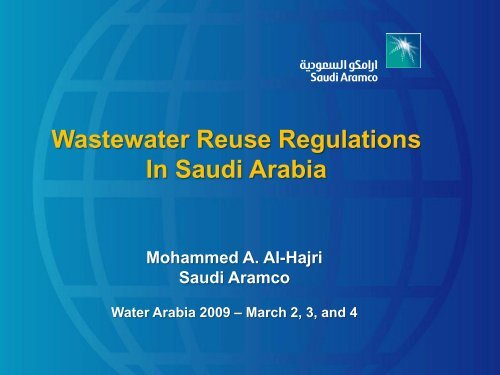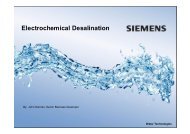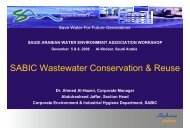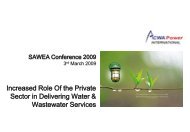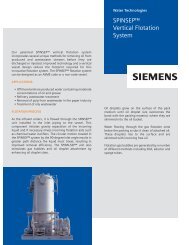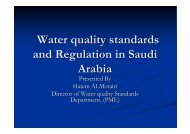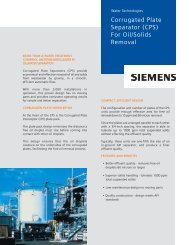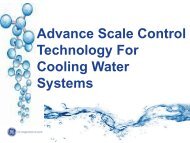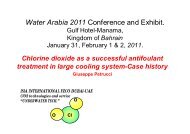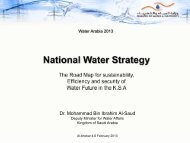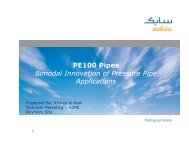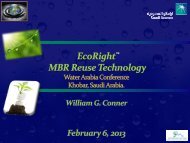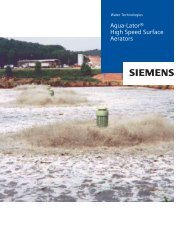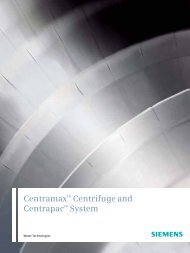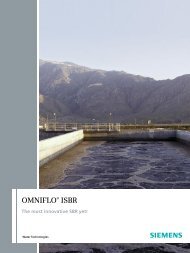Wastewater Reuse Regulations In Saudi Arabia
Wastewater Reuse Regulations In Saudi Arabia
Wastewater Reuse Regulations In Saudi Arabia
- No tags were found...
You also want an ePaper? Increase the reach of your titles
YUMPU automatically turns print PDFs into web optimized ePapers that Google loves.
<strong>Wastewater</strong> <strong>Reuse</strong> <strong>Regulations</strong><strong>In</strong> <strong>Saudi</strong> <strong>Arabia</strong>Mohammed A. Al-Hajri<strong>Saudi</strong> AramcoWater <strong>Arabia</strong> 2009 – March 2, 3, and 4
Outline• <strong>In</strong>troduction• <strong>Saudi</strong> Government <strong>Wastewater</strong> <strong>Reuse</strong> <strong>Regulations</strong>• Background• The Regulation of “Treated Sanitary <strong>Wastewater</strong> andIts <strong>Reuse</strong>”• MOMRA ROIs• MOWE ROI• Council of Ministers Decision 228• Comparison between MOWE ROI and California Title 22• <strong>Saudi</strong> Aramco <strong>Wastewater</strong> <strong>Reuse</strong> <strong>Regulations</strong>• Conclusions and Recommendations
<strong>In</strong>troduction• <strong>Saudi</strong> Aramco wastewater reuse activities started since 1980s• <strong>Saudi</strong> Aramco Daily <strong>Wastewater</strong> Generations:• Sanitary <strong>Wastewater</strong> – 21 million gallons• <strong>In</strong>dustrial <strong>Wastewater</strong> – 24 million gallons• <strong>Saudi</strong> Aramco <strong>Reuse</strong>:• Sanitary <strong>Wastewater</strong> ~ 72% (> 90% after projects completion)• <strong>In</strong>dustrial <strong>Wastewater</strong> ~ 15%• More than 15 MBR Projects• <strong>Saudi</strong> Aramco <strong>Reuse</strong> Applications:• Landscape Irrigation• Agriculture <strong>Reuse</strong>• <strong>In</strong>dustrial <strong>Reuse</strong>• Percolation Ponds
<strong>Saudi</strong> Government <strong>Wastewater</strong> <strong>Reuse</strong> <strong>Regulations</strong>Background …Royal Decree No. M/6“Treated Sanitary <strong>Wastewater</strong>and Its <strong>Reuse</strong> <strong>Regulations</strong>”Published in Um AlquraNewspaper (Issue # 3797)Council of MinistersDecision No. 228Water Conservation – GreyWaterMay 2000June 2002October 2005Published on WebsiteMOMRA Decision No. 16820Three Rules of Implementations(ROIs)Tow of the ROIs indicate that theROI is valid until January 2005Ministry of Water and ElectricityRules of Implementations for the<strong>Regulations</strong> of Treated Sanitary<strong>Wastewater</strong> and Its <strong>Reuse</strong>Valid for five (5) years
<strong>Regulations</strong>:“Treated Sanitary WW and Its <strong>Reuse</strong>”Thirty four (34) articles.Article no. 1: Objective is to providereliable standards to reuse wastewater for:• Agriculture irrigation• Landscape irrigation• Recreational places• Future groundwater recharge• Cooling• <strong>In</strong>dustrial purposes (Article no. 18excludes food industries)Article no. 1: non-conventionalwater resource.
“Treated Sanitary WW and Its <strong>Reuse</strong>”Article 3: Large complexes shall install treatment plants of their own<strong>Reuse</strong> ThresholdArticle 3: Rules of implementation shall determine the size of suchcomplexes and technical conditionsQuality• Article 6: Rules of implementation shall determinethe contaminants concentration in treatedwastewater.• Article 17: Treated wastewater for recreationalactivities shall be tertiary treated.• Article 21: Treated wastewater for direct injectionshall conforms to technically recognized standards.
MOMRA Rules of Implementation
MOMRA Rules of ImplementationROI: Sanitary WWTPs of Large Complexes<strong>Reuse</strong> ThresholdArticle 2.1.1: Water Consumption > 120 m3/day (residential units > 60)Quality• Article 2.1.8: Treated wastewater for landscape irrigation andagriculture purposes shall be tertiary quality.• Article 2.1.17: Treated wastewater shall be reused for “irrigation”and toilets water flushing systems.• Article 3.1.3: Tertiary treatment followed by disinfection• BOD5: 10 mg/L, TSS: 10 mg/L• Total Coliform < 2.2 MPN/100 ml• No limits for other pollutants such as NH3 and heavy metals
MOWE Rules of Implementation<strong>Reuse</strong> Applications:• Ag Irrigation (restricted and non-restricted)• Landscape Irrigation• Fisheries• <strong>In</strong>jection into Groundwater Aquifers• <strong>In</strong>dustries• Recreational PurposesArticle 5.5.1 requires Large Complexes:• <strong>In</strong>stall WWTPs, and• Make wastewater suitable for reuseArticle 5.5.2 requires Large Complexes:• <strong>Reuse</strong>, or• Dispose of the treated wastewater
MOWE Rules of Implementation<strong>Reuse</strong> ThresholdArticle 1.15: <strong>Wastewater</strong> generation of more than 500 m3/day(population > 2000)MOMRA, ~ 100 m3/dayMOWE, 500 m3/dayLarge Complexes <strong>Wastewater</strong> <strong>Reuse</strong>
MOWE Rules of ImplementationMOWE ROI includes 8 tables:• Table-2: Limits for secondary treated wastewater• Table-3: Limits for tertiary treated wastewater• Table-4: Extra limits for restricted irrigation water• Table-5: Extra limits for non-restricted irrigation waterParameters regulated by Table-2: Secondary Treated <strong>Wastewater</strong>Floatables TSS pH BOD5 O&G Phenol Turbidity NO3 NH3 AlFecalColiformFreeChlorineAs Be B Cd Zn Cr Co Cu FFe Pb Li Mn Hg Mo Ni Se VParameters regulated by Table-3: Tertiary Treated<strong>Wastewater</strong><strong>In</strong> addition to the thirty (30) parameters included in Table-2, Table 3 includesone more parameter: number of intestinal worms eggs
MOWE Rules of ImplementationParameterTSS(mg/L)Table-2limitsTable-3 limits40 10, monthly avg.15, weekly avg.Table-4: limits for restricted irrigationwater (agriculture)TDS (mg/L) 2500BOD5(mg/L)40 10, monthly avg.15, weekly avg.# of intestinalworms eggs1 viable egg perliterFecalColiform(MPN/100ml)1000 2.2, in a week23, any timeTable-5: limits for unrestrictedirrigation water (agriculture)TDS (mg/L) 2500# ofintestinaleggsN/A1 viable egg perliter
MOWE Rules of ImplementationQuality – Agriculture <strong>Reuse</strong>Para 6.2 (Unrestricted Irrigation): WW shall meet Table-3 and Table-5.Para 6.3 (Restricted Irrigation): WW shall meet Table-2 and Table-4.Quality – Urban IrrigationPara 7.2 (Unrestricted Access Areas): WW shall meet Table-3.Para 7.3 (Restricted Access Areas): WW shall meet Table-2.Para 7.4 (toilets flush water, streets and pavements washings, andfirefighting): WW shall meet Table-3.
MOWE Rules of ImplementationQuality – Groundwater RechargePara 10: No Specific Requirements – Approach MOWE for Permit.Quality – <strong>In</strong>dustrial <strong>Reuse</strong>Para 11.1: No Specific Requirements – Approach Ministry of <strong>In</strong>dustryand Commerce (MOIC) for Permit.Para 11.2: MOIC will identify the water quality in accordance tointended use.Para 11.3: Treated WW is not allowed in food industry.Quality – Recreational <strong>Reuse</strong>Para 12: No Specific Requirements – Approach MOWE for Permit.
Grey Water <strong>Reuse</strong>Consists of 7 SectionsSection 3, Para 1 requires theimplementation of 2 sewernetworks for water reuse for newinstallations• Exceptions: hospitalsand health centersSection 3, Para 2 requires MOWEto inform existing facilities of theimportance of water reuse.
How MOWE ROI are compared to CaliforniaTitle 22 <strong>Reuse</strong> <strong>Regulations</strong>?California Title 22 is the state of California Water Recycling Criteriaissued by the California Department of Health Services. This is awell-know and internationally recognized criteria used in thewastewater reuse field.MOWE ROI – Treated<strong>Wastewater</strong> for UnrestrictedIrrigationApplications: All food crops withoutexceptions Public parks Children playgrounds Areas patronized by publicCalifornia Title 22 –Water for IrrigationRecycledApplications: Food crops, including all edibleroot crops Parks and playgrounds School yards Recreational landscaping Unrestricted access golfcourses
MOWE ROI vs. California Title 22MOWE ROI – Treated <strong>Wastewater</strong> forUnrestricted Irrigation<strong>Wastewater</strong> shall be tertiary treated and shallmeet pollutants limits in Table-3 and Table-5.Tertiary treated wastewater means: Biologically treated Filtered DisinfectedFiltered<strong>Wastewater</strong> shall meet specific turbidity limit.No specific design parameters.Disinfected<strong>Wastewater</strong> shall meet specific fecal coliformlimit.California Title 22 –IrrigationRecycled Water for<strong>Wastewater</strong> shall be a “disinfected tertiaryrecycled water”; which means: Oxidized Filtered DisinfectedFiltered<strong>Wastewater</strong> that meets the criteria in a or b:a. Coagulated and passed through naturalor media filters pursuant to specificfiltration rates (gallons/min/ft2) andturbidity limits.b. Passed through membrane filterspursuant to specific turbidity limits.Disinfected<strong>Wastewater</strong> shall meet:a. Specific CT value or inactivationpercentage.b. Specific total coliform limits.
<strong>Saudi</strong> Aramco WW <strong>Reuse</strong> <strong>Regulations</strong><strong>Saudi</strong> Aramco has 2 documents that govern wastewater reuse:• SAES-A-104• Section 2 of the SASC
<strong>Saudi</strong> Aramco WW <strong>Reuse</strong> <strong>Regulations</strong>SAES-A-104: <strong>Wastewater</strong> Treatment, <strong>Reuse</strong>, and Disposal<strong>Reuse</strong> ThresholdPara 8.3: Water Consumption > 120 m3/day (Approx. 100 m3/day WW)QualitySAES-A-104, Table-1 and Table 16: Unrestricted Irrigation ParametersFloatables O&G pH TSS TDS Al NH3-N As BeChlorides B Ba Cd Free Cl2 Cr Co Cu CnPhenols TOC Fe Pb Mn Hg Ni NO3-N SeCOD SO4 V Zn BOD5 Viable oocystsor cystsEnteric animalviruses• F, Li, and Mo are included in Table-3 of MOWE ROI but not in SAES-A-104• Enteric animal viruses, Ba and Cn are included in SAES-A-104 but not in Table-3 of MOWE ROI
<strong>Saudi</strong> Aramco WW <strong>Reuse</strong> <strong>Regulations</strong>Quality• Para 13.2.1 (a): <strong>Wastewater</strong> for unrestricted irrigation shall beoxidized, coagulated, flocculated, and clarified, then disinfected.• Total Coliform: 2.2/100 ml in seven days (23/100 ml 30-day period)• Para 9.5.2.1 specifies filtration rate (gallons/min./ft2)• Para 10.2.1 specifies Chlorination CT and Conc. requirements• MBR shall obtain California Title 22 Certificate
Conclusions and Remarks• <strong>Saudi</strong> Aramco considers wastewater as an asset not a waste.• Sanitary WW reuse is very well established (> 72% reused) and > 90% of thegenerated sanitary WW will be reused when the ongoing projects arecompleted.• <strong>Saudi</strong> Aramco is developing a patent that will provide a cost effective method totreat the hard-to-treat industrial wastewater.• <strong>Saudi</strong> Aramco Water Conservation Team.• <strong>Saudi</strong> Aramco needs to assess its reuse effluents for Li, F, and Mo specified inthe MOWE Rules of Implementation. Also, include in the standards.• California Title 22, MOMRA ROI, <strong>Saudi</strong> Aramco: Total Coliform.MOWE ROI: Fecal Coliform.• MOWE ROI needs to re-visit the Large Complexes 500 cubic meters per dayreuse threshold and should consider the use of 100 m3/day.• MOWE ROI to include design parameters.
Thank You …
Golf Course Irrigation
Agriculture <strong>Reuse</strong>
Riyadh Refinery
Definitions – Large ComplexesLarge complexes (MOMRA)These are government or private residential, commercial orjoint complexes that perform specific activities. Theyinclude, but are not limited to, buildings of ministries,universities, military and civilian colleges, airports,companies and the like.Large complexes (MOWE)Residential, industrial, commercial or joint clusters, militarycities, university campuses, or any installation whichperform private or public activities, be they government orprivate, whose inhabitants exceed 2000 persons or whoseflow is in excess of 500 cubic meter a day.
Definitions – Restricted and UnrestrictedRestricted Irrigation:Irrigation of all plants to the exception of freshproduce, root crops, and plants whose fruits maycome into contact with the treated water, whetherthey are eaten raw or cooked.Unrestricted Irrigation:Irrigation of all types of crops with no exceptions.


